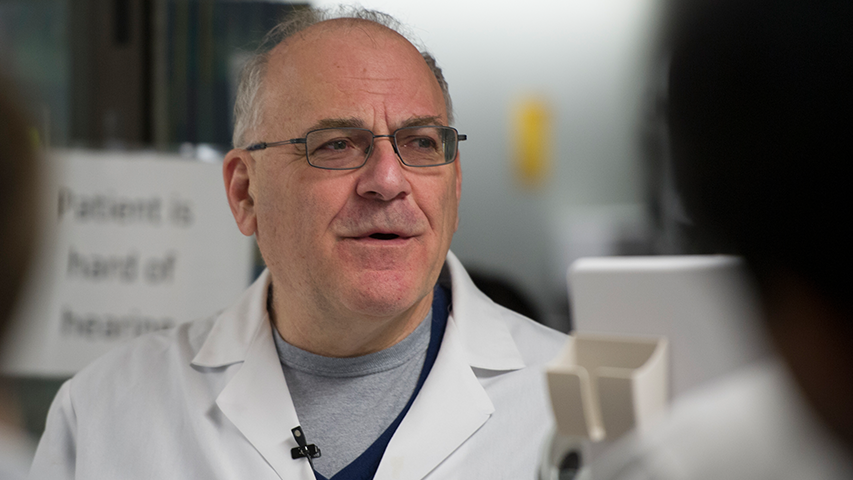- Have any questions? Contact us!
- info@dr-rath-foundation.org

Future phone apps may monitor whether patients take their prescribed drugs
April 4, 2018
Vitamin A helpful in degenerative eye disease in children
April 5, 2018Interview With Dr. Paul E. Marik – The Physician Who Says Patients With Septic Shock Have Scurvy

Responsible for the deaths of up to 8 million people globally each year, sepsis is the leading cause of death among hospitalized patients. With over 100 clinical drug trials failing to improve outcomes for sepsis patients over the last 3 decades, and the mortality rate in septic shock, the severe form of the condition, remaining as high as 50 percent, a treatment developed by Dr. Paul E. Marik, an intensive-care unit (ICU) physician at the Eastern Virginia Medical School in the United States, is showing remarkable results. In a study published in the journal Chest in 2017, Dr. Marik and colleagues describe how, based on the use of an intravenous combination of vitamin C, vitamin B1, and the hormone hydrocortisone, their approach saw just 4 deaths among the 47 patients who received it.
Pointing out in another recent paper that around 40 percent of ICU patients with septic shock have extremely low serum levels of vitamin C consistent with a diagnosis of scurvy, and that the remainder of sepsis patients similarly have insufficient levels, Dr. Marik explains how the clinical benefit of vitamin C in these conditions is synergistically enhanced by the inclusion of vitamin B1 and low-dose corticosteroids. Noting how most clinicians are unaware that primates and guinea pigs are the only mammals that are unable to synthesize vitamin C in their bodies, he says the inability to generate their own vitamin C makes humans very susceptible to dysfunction in a variety of biochemical pathways that are vital for surviving a critical illness such as sepsis.
Dr. Marik recently took time out from his busy schedule to be interviewed by Paul Anthony Taylor.
| PAUL: Could you tell us about your background and what it was that first triggered your interest in the use of vitamin C to treat sepsis? |
DR. MARIK: I did my medical school training and residency in South Africa. I have practiced in the United States for over 25 years at various teaching hospitals and am board certified in Internal Medicine and Critical Care Medicine. I had previously reviewed the literature on the use of vitamin C in patients with sepsis and was fortunate enough to be able to use this treatment successfully in a patient who was dying from the condition. This provided me the impetus to continue with this work.
| PAUL: Having had such impressive success treating sepsis with the synergistic vitamin C/vitamin B1/corticosteroid combination, were you surprised to find that your approach met with skepticism and even outright opposition in some sections of the medical community and the media? |
DR. MARIK: I was somewhat surprised by the hostility and unprofessional response that I received from a number of the so-called sepsis experts. Scientific debate is healthy, but it should not be vindictive and personal.
| PAUL: New scientific and medical ideas have often been vigorously opposed by the orthodoxy. In this sense I guess one could almost say that historically speaking you’re in good company here? |
DR. MARIK: It is not uncommon for the medical establishment to ridicule new ideas which are later considered the standard of care. Ignaz Semmelweis, an Austrian physician, was considered insane and institutionalized in an asylum for his suggestion in 1847 that handwashing could reduce the risk of puerperal sepsis. More recently, Australian scientists Barry Marshall and Robin Warren’s finding that the bacteria Helicobacter Pylori could cause stomach ulcers was considered preposterous; now, this is a well-established fact.
| PAUL: With your synergistic approach to sepsis being such a game-changing intervention in the condition, there is clearly an ethical need for information about it to be spread as far and wide as possible, especially among clinicians. How many hospitals do you know of that are currently using it, and how far would you say we are from the point at which it might eventually become the accepted standard approach? |
DR. MARIK: This approach is being used around the world, however the number of practitioners using it is difficult to determine. Once its benefits are established in randomized controlled trials then I believe it will become more universally adopted.
| PAUL: Do you envisage that the vitamin C/vitamin B1/corticosteroid combination, or variations on it, could potentially also prove useful in other critical conditions you see in your ICU? |
DR. MARIK: Yes, I think that this treatment may have a role in other acute inflammatory diseases. We have successfully treated patients with pancreatitis and non-septic adult respiratory distress syndrome (ARDS) with this cocktail. We plan to test the treatment in patients undergoing cardio-pulmonary bypass. In addition, I am sure it has a role in preserving organ function in patients undergoing solid organ transplants of the kidney, lung or heart etc.
| PAUL: In one of your lectures that I watched online you talk about a clinical trial showing that vitamin C improves mood in acutely hospitalized patients. You also state that, if you are hospitalized, your vitamin C level will be low. In the wider medical field, therefore, quite aside from ICU use, would you agree that the potential clinical uses for vitamin C are far wider than most physicians yet realize? |
DR. MARIK: Yes, I think that vitamin C (especially oral dosing) may have application in other conditions such as depression, asthma, and other allergic conditions, as well as in patients with acute delirium; however, the use in these disorders needs to be scientifically evaluated.
| PAUL: Surveys have consistently shown that medical students receive very little nutritional training in medical schools. In a recent example, research published in 2015 looked at 121 medical schools in the United States and found they were providing an average of only 19 hours of nutrition education during a four-year curriculum. Over a third of schools reported requiring 12 or fewer hours of nutritional instruction, while twelve actually required none at all. Given the resulting lack of nutritional knowledge among physicians, particularly so regarding the benefits of vitamin C in the critically ill, would you agree that, in order to get physicians to appreciate the role of vitamin deficiency in clinical disease, nutrition needs to be given a far greater focus in medical teaching than it is at present? |
DR. MARIK: Yes, 100 percent. Nutrition is almost completely ignored in the medical school curriculum. In addition, almost all clinicians have very little understanding of the role of vitamin C in health and disease and very little knowledge of the vital role vitamin C plays in sepsis and other inflammatory diseases.
| PAUL: Thank you, Dr. Marik, we’ll be looking forward to the further clinical development of your work with great interest. |



